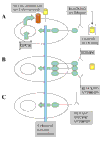Update on HER-2 as a target for cancer therapy: alternative strategies for targeting the epidermal growth factor system in cancer
- PMID: 11737891
- PMCID: PMC138706
- DOI: 10.1186/bcr328
Update on HER-2 as a target for cancer therapy: alternative strategies for targeting the epidermal growth factor system in cancer
Abstract
The epidermal growth factor (EGF) family of ligands and receptors interact to influence cell division, differentiation and motility. Much evidence supports their importance in causing and sustaining cell transformation in model systems and in human cancer. The exact mechanism by which this is achieved varies in different tumour types and from case to case. The EGF system is a target for new types of targeted chemotherapy. The choice of strategy will depend on the mechanism involved, however, and several approaches are under development or evaluation in clinical trials. Each will have a different spectrum of side effects and the potential for development of drug resistance.
Figures

References
-
- Lu H-S, Chai J-J, Huang B-R, He C-H, Bi R-C. Crystal structure of the human epidermal growth factor and its dimerisation. J Biol Chem. 2001;276:34913–34917. - PubMed
-
- Cooke RM, Wilkinson AJ, Baron M, Pastore A, Tappin MJ, Campbell ID, Gregory H, Sheard B. The solution structure of human epidermal growth factor. Nature. 1987;327:339–341. - PubMed
-
- Gullick WJ. The type 1 growth factor receptors and their ligands considered as a complex system. Endocr Relat Cancer. 2001;8:75–82. - PubMed
-
- Cohen S. EGF and its receptor: historical perspective. J Mammary Gland Biol Neoplasia. 1997;2:93–96. - PubMed
-
- Deuel TF, Huang JS, Huang SS, Stroobant P, Waterfield MD. Expression of a platelet-derived growth factor-like protein in simian sarcoma virus transformed cells. Science. 1983;21:1348–1350. - PubMed
Publication types
MeSH terms
Substances
LinkOut - more resources
Full Text Sources
Other Literature Sources
Medical
Research Materials
Miscellaneous

